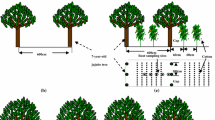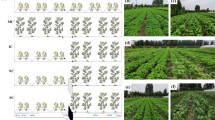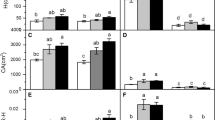Abstract
A study was conducted in northwest Florida, USA, to investigate root development and morphology of cotton (Gossypium hirsutum L.) under pecan (Carya illinoensis K. Koch) trees in an alleycropping experiment. Root:shoot ratio, root biomass, total root length and root length density were examined under three treatments: (1) barrier (separating belowground interspecific competition by trenching to a depth of 120 cm and installing polyethylene barrier), (2) non-barrier (root systems were free to interact), and (3) monoculture of cotton (without above and belowground interspecific competition with trees). Results indicated that plants in the barrier and non-barrier treatments had lower root:shoot ratios compared to the monoculture treatment. Belowground competition for resources between pecan and cotton in the non-barrier treatment resulted in 25 and 33% reduction of total root length (359 cm) when compared to that of the barrier (477 cm) and monoculture (539 cm) treatments, respectively. The non-barrier plants also exhibited the lowest root length density. Specific root length was highest for the monoculture (179 cm g−1) and lowest for the non-barrier treatment (146 cm g−1) with the barrier treatment being intermediate (165 cm g−1). Interspecific competition with pecan significantly altered root development and morphology of cotton plants. Research in agroforestry should take into account the developmental differences in root systems of the associated crop species so that better models incorporating nutrient and water uptake can be developed.


Similar content being viewed by others
References
Allen SC, Jose S, Nair PKR, Brecke BJ, Nair VD, Graetz DA, Ramsey CL (2005) Nitrogen mineralization in a pecan (Carya illinoensis K. Koch)–cotton (Gossypium hirsutum L.) alley cropping system in the southern United States. Biol Fertil Soils 41(1):28–37
Baker DN, Acock B (1986) A conceptual model of stress effects. In: Mauney JR, Stewart JM (eds) Cotton physiology. Cotton Foundation Press, Memphis Tennessee, pp 245–258
Bingham IJ, Bengough AG (2003) Morphological plasticity of wheat and barley roots in response to spatial variations in soil strength. Plant Soil 250:273–282
Bingham IJ, Blackwood JM, Stevenson EA (1997) Site, scale and time-course for adjustments in lateral root initiation in wheat following changes in C and N supply. Ann Bot 80:97–106
Cannell MGR, Van Noordwijk M, Ong CK (1996) The central agroforestry hypothesis: the tree must acquire resources that the crop would not otherwise acquire. Agofor Syst 34:27–31
Govindajaran M, Rao MR, Mathuva MN, Nair PKR (1996) Soil–water and root dynamics under hedgerow intercropping in semi-arid Kenya. Agron J 88:513–520
Gregory PJ (1994) Root growth and activity. In: Boote KJ, Bennett JM, Sinclair TR, Paulsen GM (eds) Physiology and determination of crop yield. American Society of Agronomy, Crop Science Society of America, Soil Science Society of America, Madison, Wisconsin, pp 65–93
Gregory PJ (1996) Approaches to modeling the uptake of water and nutrients in agroforestry systems. Agrofor Syst 34:51–65
Jose S, Gillespie AR, Seifert JR (2000) Defining competition vectors in a temperate alley cropping system in the Midwestern USA. 2. Competition for water. Agrofor Syst 48:41–49
Jose S, Gillespie AR, Seifert JR, Pope PE (2001) Comparison of minirhizotron and soil core methods for quantifying root biomass in a temperate alley cropping system. Agrofor Syst 52:161–181
Jose S, Merritt S, Ramsey CL (2003) Growth, nutrition, photosynthesis and transpiration responses of longleaf pine seedlings (Pinus palustris Mill.) to light, water and nitrogen. For Ecol Manage 180:335–344
Jose S, Gillespie AR, Pallardy SG (2004) Interspecific interactions in temperate agroforestry. Agrofor Syst 61:237–255
Jose S, Williams RA, Zamora DS (2006) Belowground ecological interactions in mixed-species forest plantations. For Ecol Manage 233:231–239
Kasperbauer MJ, Busscher WJ (1991) Genotypic differences in cotton root penetration of a compacted sub-soil layer. Crop Sci. 31:1376–1378
Keino J (1998) Characterization of cotton roots in relation to plant growth, water management and potassium kinetic uptake parameters. PhD Dissertation, University of Arkansas, Fayetteville, Arkansas, USA
Klepper B, Taylor HM, Huck MG, Ficus FL (1973) Water relations and growth of cotton in drying soils. Agron J 65:307–310
Lambers H, Chapin III FS, Pons TL (1998) Plant physiological ecology. Springer-Verlag, New York City, p 540
Lehmann J, Peter I, Steglich C, Gebauer G, Huwe B, Zech W (1998) Belowground interactions in dryland agroforestry. For Ecol Manage 111:157–169
Livesley SJ, Gregory PJ, Buresh RJ (2000) Competition in tree-row agroforestry systems. 1. Distribution and dynamics of fine roots length and biomass. Plant Soil 227:149–161
Lynch J (1995) Root architecture and plant productivity. Plant Physiol 109:7–13
McMichael BL, Upchurch DR, Burke JJ (1996) Soil temperature derived prediction of root density in cotton. Environ Exp Bot 36:303–312
Newman EI (1966) A method of estimating the total length of roots in a sample. J Appl Ecol 3:139–145
Ong CK, Black CR (1995) Complementarity in resource use in agroforestry systems. In: Kang BT, Osiname AO, Larbi A (eds) Alley farming research and development. International Institute of Tropical Agriculture (ITTA) Publisher, Ibadan Nigeria, pp 73–89
Ong CK, Corlett JE, Singh RP, Black CR (1991) Above and belowground interactions in agroforestry systems. For Ecol Manage 45:45–57
Plaut Z, Carmi A, Grava A (1996) Cotton root and shoot responses to sub-surface drip irrigation and partial wetting of the upper soil profile. Irrig Sci 16:107–113
Reddy VR, Wang Z, Reddy KR (1997) Growth responses of cotton to aldicarb and temperature. Environ Exp Bot 38:39–48
Robinson D (1994) The response of plants to non-uniform supplies of nutrients. New Phytol 127:635–674
Rosolem CA, Joao PT, Vanzolini S, Ramos VJ (1999) The significance of root growth on cotton nutrition in an acidic low-P soil. Plant Soil 212:185–190
Sack L, Grubb PJ (2002) The combined impacts of deep shade and drought on the growth and biomass allocation of shade-tolerant woody seedlings. Oecologia 131:175–185
Schroth G (1999) A review of belowground interactions in agroforestry: focusing on mechanisms and management options. Agrofor Syst 43:5–34
Schroth G, Zech W (1995) Root length dynamics in agroforestry with Gliricidia sepium as compared to sole cropping in the semi-decidous rainforest zone of West Africa. Plant Soil 170:297–306
Singh RP, Ong CK, Saharan N (1989) Above and below ground interactions in alleycropping in semi-arid India. Agrofor Syst 9:259–274
Smith T, Huston M (1989) A theory of the spatial and temporal dynamics of plant-communities. Vegetatio 83:49–69
Taylor HM, Klepper B (1974) Water relations of cotton. I. Root growth and water use as related to top growth and soil water content. Agron J 66:584–588
Teklehaimanot JB, Quedraogo SJ (2004) Fine root distribution of pruned trees and associated crops in parkland system in Burkina Faso. Agrofor Syst 60:13–26
Tennant D (1975) A test of a modified line intersect method of estimating root length. J Ecol 63:995–1001
Van Noordwijk M, Purnomosidhi MP (1995) Root architecture in relation to tree–soil–crop interactions and shoot pruning in agroforestry. Agrofor Syst 30:161–173
Van Noordwijk M, Spek LY, de Willegen P (1994). Proximal root diameter as predictor of total root size for fractal branching models. Plant Soil 161:107–117
Wanvestraut RH, Jose S, Nair PKR, Brecke BJ (2004) Competition for water in a pecan (Carya illinoensis K. Koch) – cotton (Gossypium hirsutum L.) alleycropping system in southern United States. Agrofor Syst 60:167–179
Zamora DS, Jose S, Nair PKR (2006a) Interspecific competition in a pecan–cotton alleycropping system in the southern United States: production physiology. Can J Bot (in press)
Zamora DS, Jose S, Nair PKR (2006b) Interspecific competition in a pecan–cotton alleycropping system in the southern United States: is light the limiting factor? In: Jose S, Gordon A (eds) Towards agroforestry design: an ecological approach. Springer-Verlag, NY (in press)
Zhang HM, Forde BG (1998) An arabidopis MADS box genes that controls nutrient-induced changes in root architecture. Science 279:407–409
Acknowledgments
Special thanks are extended to Dr Johannes Scholberg for allowing us to use the Winrhizo equipment and program; Corey Cherr for the technical help in using the Winrhizo; Jeremy Monnot, D. Hatfield and J. Nelson for assistance in field and laboratory. This study was funded by the Center of Subtropical Agroforestry (CSTAF) at the University of Florida through USDA-CSREES grant 00-52103-9702, and also by the USDA Southern Region Sustainable Agriculture Research and Education (SARE) program (# LS02-136).
Author information
Authors and Affiliations
Corresponding author
Rights and permissions
About this article
Cite this article
Zamora, D.S., Jose, S. & Nair, P.K.R. Morphological plasticity of cotton roots in response to interspecific competition with pecan in an alleycropping system in the southern United States. Agroforest Syst 69, 107–116 (2007). https://doi.org/10.1007/s10457-006-9022-9
Received:
Accepted:
Published:
Issue Date:
DOI: https://doi.org/10.1007/s10457-006-9022-9




